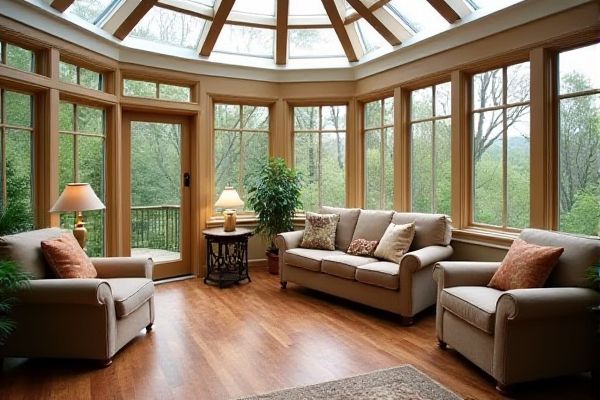
A heated sunroom offers year-round comfort by maintaining a warm environment regardless of outdoor temperatures, while a non-heated sunroom is best suited for milder weather and seasonal use. Discover the benefits and drawbacks of each option to determine which sunroom fits Your lifestyle and climate needs by reading the rest of the article.
Table of Comparison
| Feature | Heated Sunroom | Non-Heated Sunroom |
|---|---|---|
| Temperature Control | Maintains comfortable warmth year-round | Depends on outdoor temperature, can be cold in winter |
| Usage | Year-round use including winter months | Limited to warmer seasons |
| Energy Consumption | Higher due to heating system | Low, no heating required |
| Installation Cost | Higher initial cost with heating system installation | Lower initial cost |
| Comfort | Consistent comfort regardless of outside weather | Comfort varies with outdoor conditions |
| Maintenance | Requires heating system upkeep | Minimal maintenance |
| Resale Value | Potentially higher due to enhanced usability | Standard value |
| Insulation | Better insulation to support heating efficiency | Usually less insulation |
Introduction: Heated vs Non-Heated Sunrooms
Heated sunrooms maintain a comfortable indoor temperature year-round, enabling you to enjoy natural light without sacrificing warmth during colder months. Non-heated sunrooms rely on ambient outdoor temperatures, making them suitable for mild climates and seasonal use but less effective in winter. Choosing between heated and non-heated options depends on your climate, budget, and how often you plan to use the space throughout the year.
Key Differences Between Heated and Non-Heated Sunrooms
Heated sunrooms offer year-round comfort with insulation, climate control, and energy-efficient windows, while non-heated sunrooms provide a more affordable space but only suitable during warmer months. The primary differences lie in temperature regulation, construction costs, and energy consumption, impacting your usability and maintenance expenses. Choosing a heated sunroom enhances your home's value and usability, especially in colder climates.
Climate Considerations for Sunroom Choice
Heated sunrooms provide year-round comfort by maintaining indoor temperatures in colder climates, making them ideal for regions with harsh winters or fluctuating temperatures. Non-heated sunrooms are more suitable for temperate or warm climates where mild weather allows for comfortable use without additional heating. Climate considerations strongly influence energy efficiency, usability, and construction materials when choosing between heated and non-heated sunroom options.
Energy Efficiency and Insulation Factors
Heated sunrooms offer superior energy efficiency due to enhanced insulation materials and climate control systems that maintain consistent indoor temperatures, reducing overall heating costs. Non-heated sunrooms generally rely on passive solar gain, which results in greater temperature fluctuations and increased heat loss during cooler months. You can optimize your home's energy performance by selecting a heated sunroom with double or triple-pane windows and insulated frames to minimize thermal bridging.
Cost Comparison: Installation and Maintenance
Heated sunrooms typically involve higher installation costs due to the need for insulation, heating systems, and upgraded windows designed to retain warmth, compared to non-heated sunrooms which require minimal structural modifications. Maintenance expenses for heated sunrooms may include servicing HVAC components and increased energy costs, while non-heated sunrooms demand less upkeep primarily focused on window cleaning and structural integrity. Investing in a heated sunroom offers year-round usability but results in higher overall costs than the more budget-friendly, seasonal use non-heated sunroom option.
Year-Round Usability and Comfort
Heated sunrooms provide year-round usability by maintaining comfortable temperatures during cold months, allowing homeowners to enjoy the space regardless of seasonal changes. Non-heated sunrooms, while offering natural light and ventilation, often become unusable or uncomfortable in winter due to lack of temperature control. Investing in a heated sunroom enhances comfort and extends the functional living area throughout the entire year.
Impact on Home Value and Resale
A heated sunroom significantly enhances your home's value by offering year-round usability and improved energy efficiency, attracting more buyers seeking comfortable living spaces. In contrast, non-heated sunrooms may limit appeal during colder months, potentially reducing resale value due to seasonal usability constraints. Investing in a heated sunroom can provide a higher return on investment by increasing overall market competitiveness and buyer interest.
Furniture and Decor Options
Heated sunrooms allow for a wider range of furniture and decor options as temperature and humidity levels remain controlled, preventing damage to sensitive materials like wood and upholstery. Non-heated sunrooms often require weather-resistant or outdoor furniture made from materials such as aluminum, wicker, or synthetic resin to withstand fluctuating temperatures and moisture. Choosing durable, fade-resistant fabrics and decor ensures longevity and comfort in non-heated spaces, while heated sunrooms offer flexibility for more luxurious and delicate interior design elements.
Best Uses for Each Sunroom Type
Heated sunrooms are ideal for year-round use, providing a comfortable retreat regardless of cold weather, perfect for entertaining, working, or relaxing through all seasons. Non-heated sunrooms excel in mild climates and are best suited for seasonal enjoyment, such as spring and summer, offering a bright space to enjoy natural light without added energy costs. Your choice depends on your climate, intended use, and budget for heating and insulation.
Choosing the Right Sunroom for Your Lifestyle
Heated sunrooms provide year-round comfort with efficient insulation and temperature control, making them ideal for colder climates or extended use. Non-heated sunrooms offer a cost-effective option for seasonal enjoyment, relying on natural sunlight and ventilation to maintain a pleasant environment. Selecting between these options depends on lifestyle preferences, climate considerations, and budget for ongoing energy costs.
 homyna.com
homyna.com